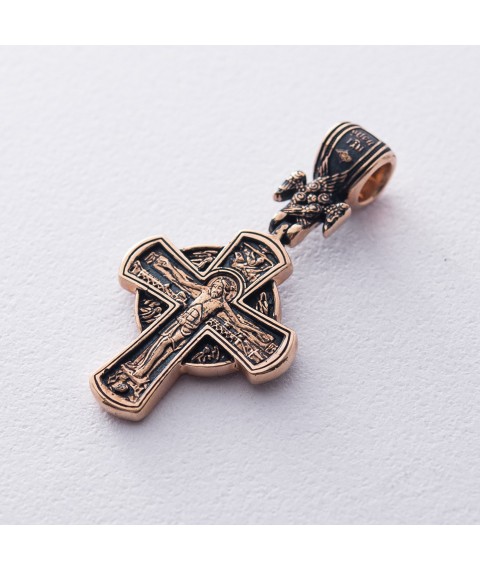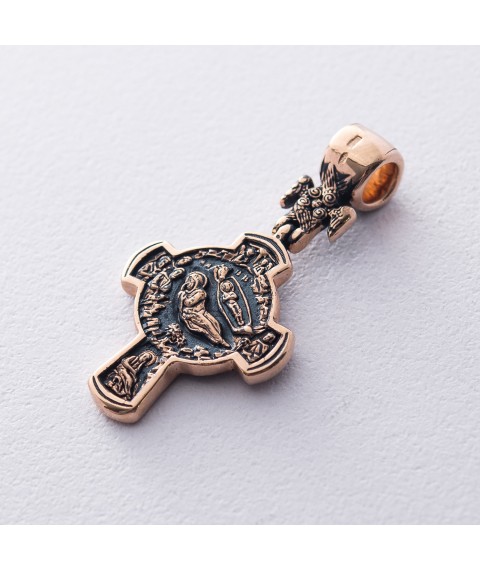Golden Orthodox cross with blackening "Crucifixion. Nativity of Christ"
Metal: red gold 585"
Average weight: 11.44 g
Height with eye: 4.4 cm
Height without eyelet: 2.7 cm
Width: 2.2 cm
Ear dimensions: 0.6 cm
The front side of the cross traditionally depicts the Crucified Lord Jesus Christ. The reverse side is dedicated to the feast of the Nativity of our Lord Jesus Christ - an event that many peoples consider the most important in the history of mankind. It is with Christmas that the era that we habitually call “ours” begins.
In the New Testament, the story of the Nativity of Christ is described by two evangelists - Matthew and Luke. The Gospel of the Apostle Matthew tells the famous Christmas story about the worship of the Magi - Eastern magicians who came to the newborn Jesus Christ, following a star. The Magi presented gifts: gold, incense and myrrh (fragrant oil). These gifts had a symbolic meaning: they brought gold to Christ as a King - as a tax, incense - as to God, because incense is used in worship, and myrrh - as to a Man who is mortal (in those days the dead were anointed with oils containing myrrh). That is, these gifts point to the kingly, divine, and human ministry of Jesus.
The Gospel of the Apostle Luke sets out other events associated with Christmas: this is a story about the nativity scene, the manger and the worship of the Infant Christ by shepherds and angels. Evangelist Luke writes that at the time when the Virgin Mary was about to give birth, a census began in Judea. The Jews had the custom of conducting national censuses by tribes, tribes and clans, and each tribe and clan had its own specific cities and ancestral places. That is why the Virgin Mary and Joseph went to Bethlehem: their ancestor, King David, was born there. But there was no room in the hotel in the city. The family settled down for the night in a cave, where cattle were driven in bad weather. The Savior was born in this cave. Having given birth to the Son, the Most Holy Virgin Herself swaddled Him and placed Him in a manger, that is, in a feeding trough for animals. Although the evangelist does not indicate the presence of animals in the cave, one of the Old Testament prophecies about the birth of the Messiah, the prophecy of Isaiah, says: “The ox knows his owner, and the donkey his master’s manger; but Israel does not know Me, My people do not understand” (Isa. 1:3). And this prophecy was fulfilled: the animals were the first to greet the newborn Christ. Jesus Christ was born at night, when everyone in Bethlehem and the surrounding area was already asleep.Only the shepherds guarding the flock were awake. Evangelist Luke indicates that an Angel appeared to them and they hastened to worship the Savior and His Mother.
In the icons of the Nativity, two stories are combined: the Magi, shepherds and angels are depicted next to the Mother of God and the manger of Christ. Baby Jesus is the smallest. The small size of His figure is a symbol of the endless humiliation of God, who, for the sake of saving humanity, incarnated himself into a small helpless child. Our Lady, on the contrary, is huge. It exceeds the scale of people, angels and even mountains. This is a symbol of Her exaltation: after all, having given birth to the God-Man, the Mother of God became above all angels and archangels.
* Attention. Product description can be obtained by machine translation.
| Specification |
| article |
п02647 |
| Coating |
Чернение |
| Country |
Украина |
| Country of manufacture |
Україна |
| Insert |
Без каменів |
| Manufacturer's country |
Украина |
| Metal |
Всё золото , Красное золото 585" |
| Type of jewelry |
Крестики |
| Weight, g |
11.44 |
| Вага, г |
11.44 |
| Вид прикраси |
Хрестики |
| Країна |
Україна |
| Метал |
Все золото , Червоне золото 585" |
| Покриття |
Чорніння |

